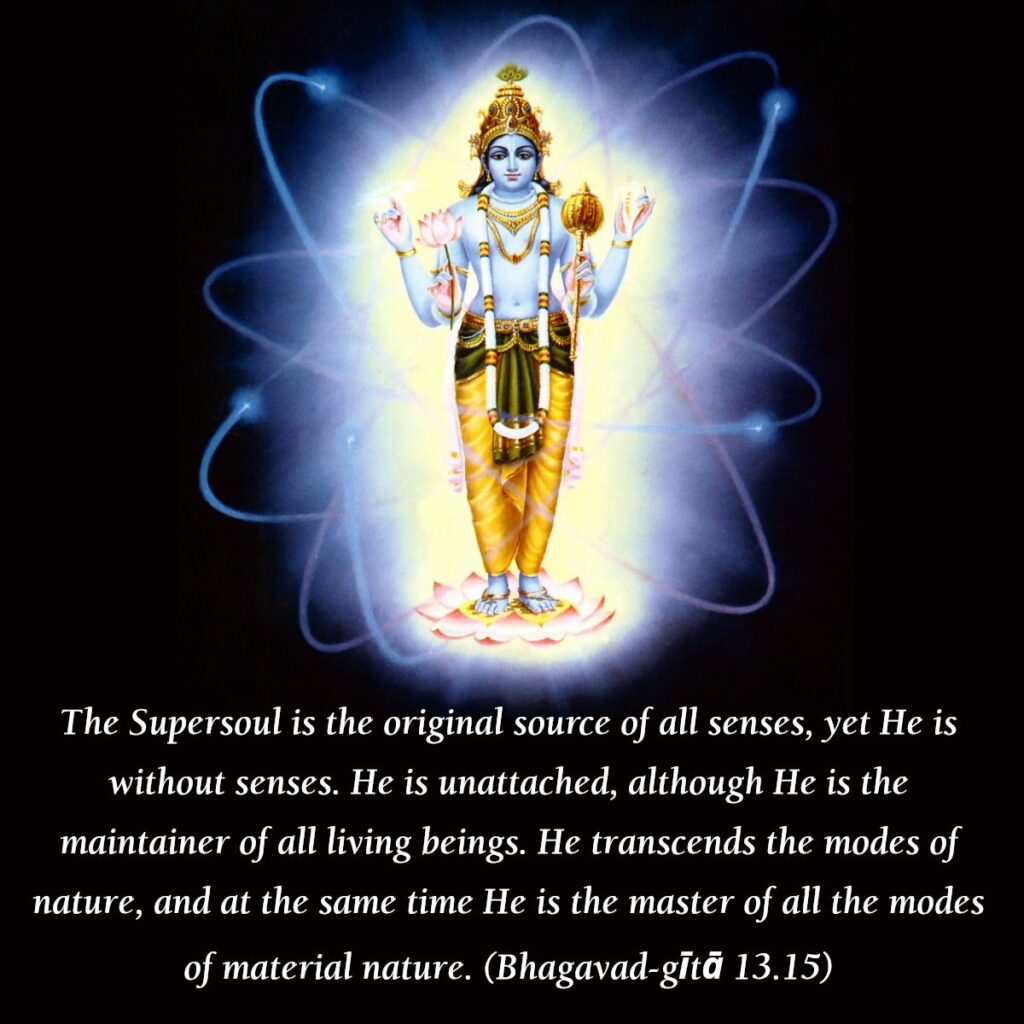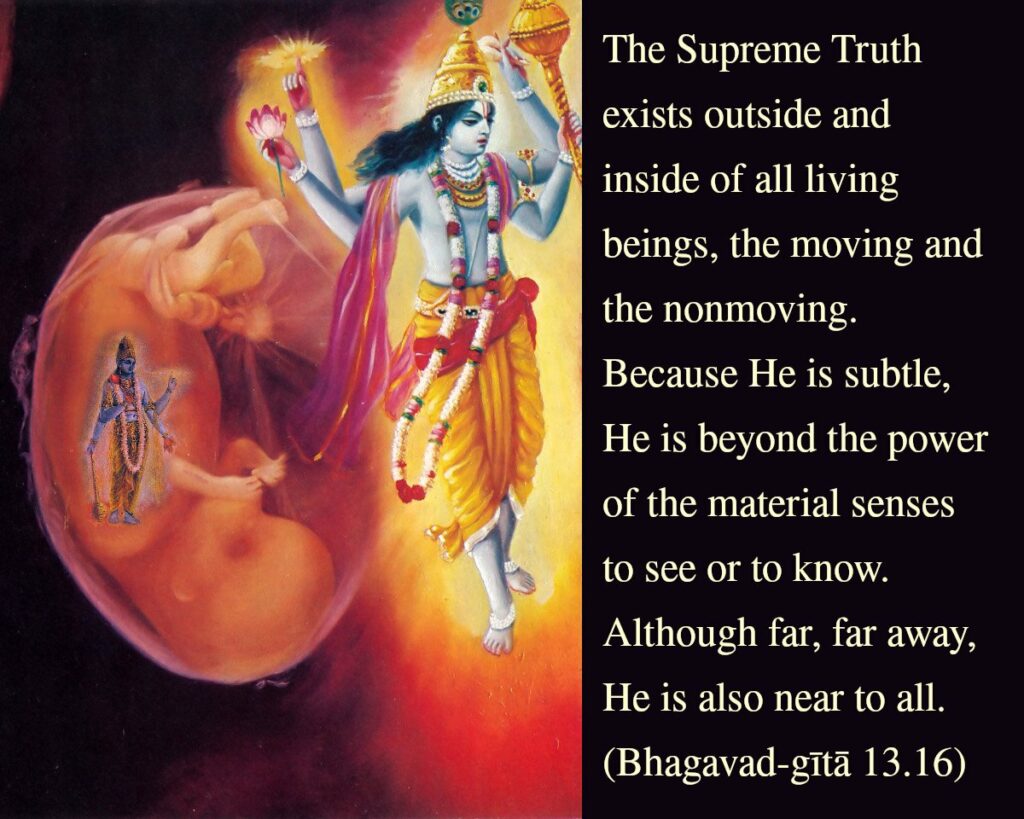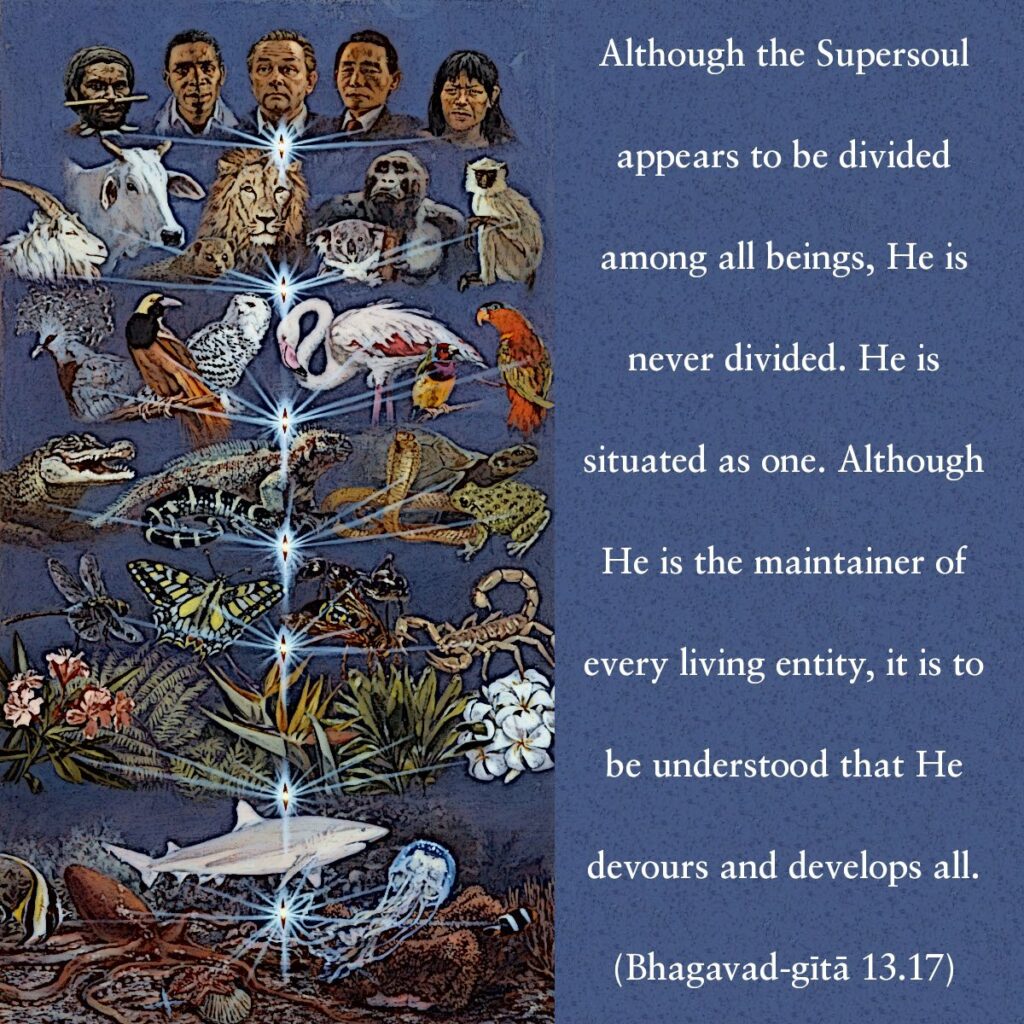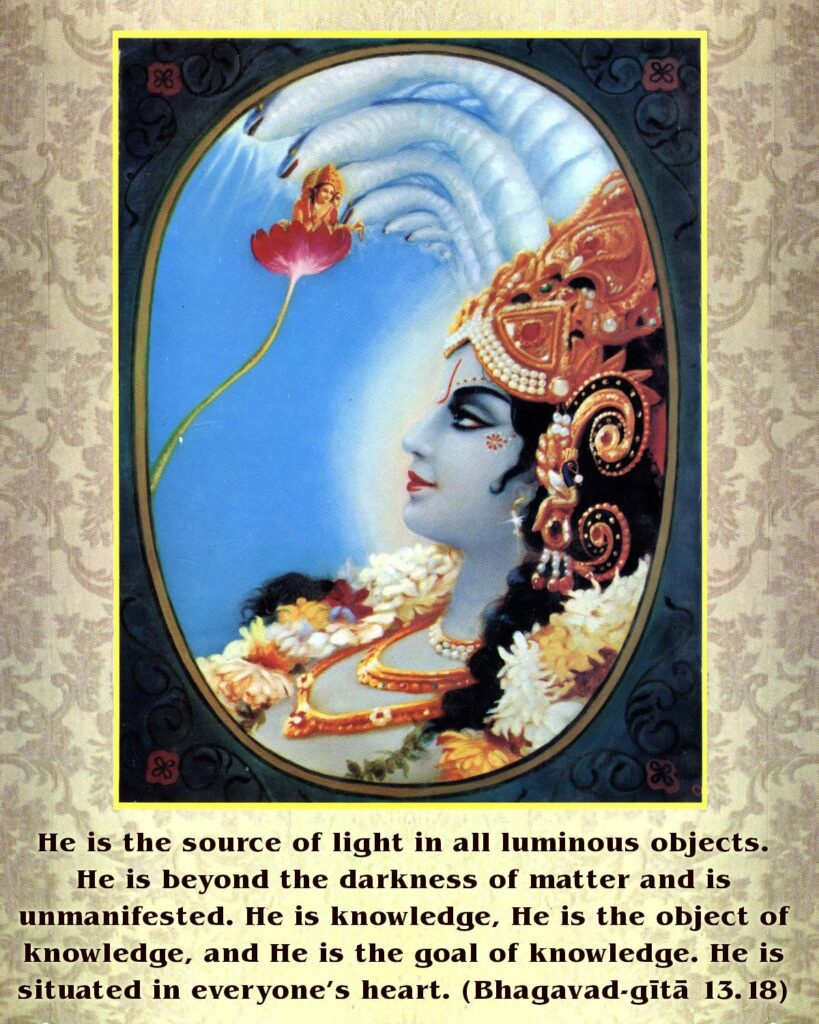सर्वेन्द्रियगुणाभासं सर्वेन्द्रियविवर्जितम् |
असक्तं सर्वभृच्चैव निर्गुणं गुणभोक्तृ च || 15||
बहिरन्तश्च भूतानामचरं चरमेव च |
सूक्ष्मत्वात्तदविज्ञेयं दूरस्थं चान्तिके च तत् || 16||
अविभक्तं च भूतेषु विभक्तमिव च स्थितम् |
भूतभर्तृ च तज्ज्ञेयं ग्रसिष्णु प्रभविष्णु च || 17||
ज्योतिषामपि तज्ज्योतिस्तमस: परमुच्यते |
ज्ञानं ज्ञेयं ज्ञानगम्यं हृदि सर्वस्य विष्ठितम् || 18||
sarvendriya-guṇābhāsaṁ sarvendriya-vivarjitam
asaktaṁ sarva-bhṛich chaiva nirguṇaṁ guṇa-bhoktṛi cha
bahir antaśh cha bhūtānām acharaṁ charam eva cha
sūkṣhmatvāt tad avijñeyaṁ dūra-sthaṁ chāntike cha tat
avibhaktaṁ cha bhūteṣhu vibhaktam iva cha sthitam
bhūta-bhartṛi cha taj jñeyaṁ grasiṣhṇu prabhaviṣhṇu cha
jyotiṣhām api taj jyotis tamasaḥ param uchyate
jñānaṁ jñeyaṁ jñāna-gamyaṁ hṛidi sarvasya viṣhṭhitam
sarva—all; indriya—senses; guṇa—sense-objects; ābhāsam—the perciever; sarva—all; indriya—senses; vivarjitam—devoid of; asaktam—unattached; sarva-bhṛit—the sustainer of all; cha—yet; eva—indeed; nirguṇam—beyond the three modes of material nature; guṇa-bhoktṛi—the enjoyer of the three modes of material nature; cha—although; bahiḥ—outside; antaḥ—inside; cha—and; bhūtānām—all living beings; acharam—not moving; charam—moving; eva—indeed; cha—and; sūkṣhmatvāt—due to subtlety; tat—he; avijñeyam—incomprehensible; dūra-stham—very far away; cha—and; antike—very near; cha—also; tat—He; avibhaktam—indivisible; cha—although; bhūteṣhu—amongst living beings; vibhaktam—divided; iva—apparently; cha—yet; sthitam—situated; bhūta-bhartṛi—the Sustainer of all beings; cha—also; tat—that; jñeyam—to be known; grasiṣhṇu—the Annihilator; prabhaviṣhṇu—the Creator; cha—and; jyotiṣhām—in all luminarie; api—and; tat—that; jyotiḥ—the source of light; tamasaḥ—the darkness; param—beyond; uchyate—is said (to be); jñānam—knowledge; jñeyam—the object of knowledge; jñāna-gamyam—the goal of knowledge; hṛidi—within the heart; sarvasya—of all living beings; viṣhṭhitam—dwells
Translation:
It shines through the functions of all the senses, and yet It is devoid of senses. It is unattached, and yet It sustains all. It is devoid of gunas, and yet It enjoys them.
It is without and within all beings. It is unmoving and also moving. It is incomprehensible because It is subtle. It is far away, and yet It is near.
It is indivisible, and yet It is, as it were, divided among beings. That Knowable Brahman is the Sustainer of all beings, and also their Devourer and Generator.
The Light even of lights, It is said to be beyond darkness. As knowledge, the object of knowledge, and the goal of knowledge, It is set firm in the hearts of all.
Commentary:
In these verses, the Knowable (Brahman) is stated vividly. ‘Jnanagamyam‘ the qualities themselves are not the goal. The goal is Brahman. Whatever path is followed, Karma, Bhakti, Yoga or Dhyana, the end of the spiritual pilgrimage is Brahman. Brahma-Jnana liberates man from the horrible dream of ignorance, birth and death. Man knows the reality and that he is himself one with the Reality. The little ‘I’ did not and does not exist. So the seeker should contemplate the Knowable (Jneyam: Brahman) and realise his identity with That.
The idea is that with the destruction of the vasanas, one should possess the Knowledge of the Supreme. ‘Sadhana’ and knowledge of ‘Sadhya’ are both necessary. The aim of the Gita is to clear the path and also attain the goal. Man’s glorious destiny is the Realisation of Brahman.
May all the seekers discard all foolish and impure notions of their being flesh and blood and know themselves to be the blissful and ever-blessed Paramatma.
asaktam: (drik) Atma does not touch the objective world (drisya prapancham.)
bahirantas cha bhutanam: He is both inside and outside all beings. So near He is to beings, witnessing all that they think and do, that they should never commit evil and sin in any manner what-so-ever.
acharam charam eva cha: He is moving and unmoving; How can this be? In the dream state man imagines that he is moving here and there and doing so many things. But does he really move? No. He is lying down in his bed. So also, this Universe in the form of beings is moving, and as Brahman it is unmoving. The real man, being Brahman does not move. What moves is the Drisya prapancham (Prakriti). Or it may also be interpreted that He is both the objects like animals and birds and so on, and also the unmoving like mountains and trees etc.
sukshmatvat avijneyam: There are three ethers 1. The material ether (Sthulakasa) 2. The mental ether (Chittakasa) 3. The Intelligene ether (Chidakasa). One is more subtle than the other. The third is the subtlest of all. This Chidakasa is the knowable Brahman. It is unseen by the physical eye, by the mental eye, by the eyes of the ignorant. Only the vision of knowledge reveals the Supreme.
antike cha tat: He is near, very near to the people. Knowing this they should be free from all evil and sin.
vibhaktamiva cha: Brahman is undivided. He does not exist as a separate entity in the beings of the world. It would be absurd to think that each man has a separate Brahman of his own. It is the one Being who is present in all. On account of ‘avidya’ it appears as though He is divided. That is why the word ‘iva’ is used. In a pot of water, in the river, in the ocean, the Sun’s reflection is seen differently. But the Sun is only one. Exactly in that manner, the one Brahman, who is shining through the millions of beings, appears to be divided but is not really divided. Like the string keeping together different flowers, He exists all alone sustaining the manifold universe. Brahman being infinite there cannot be any separateness or division in Him. The aim of spiritual ‘sadhana’ is to know that one in this manifold Universe of name and form.
Bhutabhatricha, grasishnu prabhavishnu cha: He is the supporter, the creator and the destroyer. He is Brahma, Vishnu and Siva.
tamasah param: All these worlds, mind and buddhi, are in the realm of ‘avidya‘. This ignorance is itself darkness. The Lord is beyond the darkness of ‘avidya’ (aditya varnam tamasah parastat 8.9).
jnanam, jneyam, jnanagamyam: The first word (jnana) stands for knowledge. The second word (Jneyam) means Atman. The third is ‘Jnanagamyam’ – Here the word ‘jnanam’ stands for qualities like humility etc., which lead to the understanding of Brahman. Jneyam that which is to be known, the knowable (i.e.) the Supreme Brahman. This alone takes man beyond samsara. No other knowledge can achieve this liberation for mankind.
How then to realise God? Certainly, the answer is by the full possession of the qualities of Jnana-like amanitvam, ‘adambhitvam’ etc. There is no other way. Let the seekers be perfectly clear about this point, and strive hard to cultivate every one of the divine virtues.
hridi sarvasya vishtitam: He is in the heart of all. From worms and germs up to Brahma (Creator) the Lord is present in every being, in the moving and the unmoving. There is nothing where he is not. This being the highest truth, each one can realise Him in His own heart. Whether one looks out at the manifested universe or looks within at the Atma the same Brahman exists. There cannot be any distinction between high or low or big or small. Everyone can hope to realise Him, whoever he is and wherever he may stand in the scheme of things.
Sri Ramakrishna Says —
Ishan intended to retire to a solitary place and practise a special discipline of the Gayatri, through which Brahman is invoked. But the Master said that the Knowledge of Brahman was not possible without the complete destruction of worldliness. Further, he said that it was impossible for a man totally to withdraw his mind from the objects of the senses in the Kaliyuga, when his life was dependent on food. That is why the Master discouraged people from attempting the Vedic worship of Brahman and asked them to worship Sakti, the Divine Mother, who is identical with Brahman.
MASTER (to Ishan): “Why do you waste your time simply repeating ‘Neti, neti’? Nothing whatsoever can be specified about Brahman, except that It exists.
“Whatever we see or think about is the manifestation of the glory of the Primordial Energy, the Primal Consciousness. Creation, preservation, and destruction, living beings and the universe, and further, meditation and the meditator, bhakti and prema — all these are manifestations of the glory of that Power.
“But Brahman is identical with Its Power. On returning from Ceylon, Hanuman praised Rama, saying: ‘O Rama, You are the Supreme Brahman, and Sita is Your Sakti. You and She are identical.’ Brahman and Sakti are like the snake and its wriggling motion. Thinking of the snake, one must think of its wriggling motion, and thinking of its wriggling motion, one must think of the snake. Or they are like milk and its whiteness. Thinking of milk, one has to think of its colour, that is, whiteness, and thinking of the whiteness of milk, one has to think of milk itself. Or they are like water and its wetness. Thinking of water, one has to think of its wetness, and thinking of the wetness of water, one has to think of water.
“This Primal Power, Mahamaya, has covered Brahman. As soon as the covering is withdrawn, one realises: ‘I am what I was before’, ‘I am Thou; Thou art I’.
“As long as that covering remains, the Vedantic formula ‘I am He’, that is, man is the Supreme Brahman, does not rightly apply. The wave is part of the water, but the water is not part of the wave. (BG 9.4) As long as that covering remains, one should call on God as Mother. Addressing God, the devotee should say, ‘Thou art the Mother and I am Thy child; Thou art the Master and I am Thy servant.’ It is good to have the attitude of the servant toward the master. From this relationship of master and servant spring up other attitudes: the attitude of serene love for God, the attitude of friend toward friend, and so forth. When the master loves his servant, he may say to him, ‘Come, sit by my side; there is no difference between you and me.’ But if the servant comes forward of his own will to sit by the master, will not the master be angry?
“God’s play on earth as an Incarnation is the manifestation of the glory of the Chitsakti, the Divine Power. That which is Brahman is also Rama, Krishna, and Siva.”
ISHAN: “Yes, sir. Both Hari and Hara are derived from the same root. The difference lies only in the pratyaya.”
MASTER: “Yes, there is only One without a second. The Vedas speak-of It as ‘Om Satchidananda Brahma’, the Puranas as ‘Om Satchidananda Krishna’, and the Tantra as ‘Om Satchidananda Siva’.
“The Chitsakti, as Mahamaya, has deluded all with ignorance. It is said in the Adhyatma Ramayana that when the rishis saw Rama, they prayed to Him in these words only: ‘O Rama, please do not delude us with Your world-bewitching maya.'” (Source: Gospel of Sri Ramakrishna)
—–
A few minutes afterwards Narendra entered the room with a friend, whom he introduced to the Master as an author. Sri Ramakrishna talked with him about the metaphysical significance of Radha and Krishna. The author said that Radha and Krishna were the Supreme Brahman. Vishnu, Siva, Durga, and the other deities had sprung from them.
MASTER: “That is good. There are different aspects of Radha. In Her seductive aspect She was Chandravali. In Her aspect of love She participated in Sri Krishna’s lila at Vrindavan. Nandaghosh, Krishna’s foster-father, had the vision of the Eternal Radha.
“First is the seductive Radha, then the Radha of love. If you go farther, you will see the Eternal Radha. It is like taking off the layers of an onion one by one. First the red layers, then the pink, then the white. Afterwards you don’t find any more layers. Such is the nature of the Eternal Radha, Radha the Absolute. There the discrimination following the process of ‘Not this, not this’ comes to an end.
“There are two aspects of Radha-Krishna: the Absolute and the Relative.
They are like the sun and its rays. The Absolute may be likened to the sun, and the Relative to the rays.
“A genuine bhakta dwells sometimes on the Absolute and sometimes on the Relative. Both the Absolute and the Relative belong to one and the same Reality. It is all one — neither two nor many.”
AUTHOR: “Sir, why do they speak of the ‘Krishna of Vrindavan’ and the ‘Krishna of Mathura’?”3
MASTER: “That is the view of the goswamis. But the scholars of upper India think differently. According to these scholars there is only Krishna, and no Radha. The Krishna of Dwaraka is not associated with Radha.”
AUTHOR: “Sir, Radha and Krishna are themselves the Supreme Brahman.”
MASTER: “That is good. But you must remember that everything is possible for God. He is formless, and again He assumes forms. He is the individual and He is the universe. He is Brahman and He is Sakti. There is no end to Him, no limit. Nothing is impossible for Him. No matter how high the kites and vultures soar, they can never strike against the ceiling of the sky. If you ask me what Brahman is like, all I can say is that It cannot be described in words. Even when one has realised Brahman, one cannot describe It. If someone asks you what ghee is like, your answer will be, ‘Ghee is like ghee.’ The only analogy for Brahman is Brahman. Nothing exists besides It.” (Source: Gospel of Sri Ramakrishna)
Related Articles:
- If the radiance of a thousand suns were to burst forth at once in the sky, that would be like the splendour of the Mighty One. (BG 11.12)
- There, in the person of the God of gods, Arjuna beheld the whole universe, with its manifold divisions, all gathered together in one. (BG 11.13)
- In all the beings separated into different categories, that knowledge which sees the one inseparable Reality (Atma), know it to be Sattvic Jnana. (BG 18.20)
Question: What is the nature of jneyam (Parabrahman)?
Answer:
1. That Brahman having hands and legs everywhere and every where having heads and faces, and having ears everywhere exists in the Universe, 2. It pervads all the Universe, 3. It shines by the functions of all the senses, 4. It is without the senses, 5. It is unattached, 6. It supports all, 7. It is without the three qualities i.e. sattva, rajas and tamas, 8. It is the experiencer of the qualities, 9. It exists within and without all beings, 10. It is unmoving, 11. and it is moving, 12. It is unknowable to ignorant 15. because of its subtlity, 13. It is far away, 14. It is near, 15. It is indivisible but exists as if divided in beings, 16. It is the supporter of beings, 17. It is worthy to be known, 18. It is destroying and also generating, 19. That Brahman is the Light of the shining objects like the Sun, the Moon and the fire, 20. It is beyond darkness (ignorance), 21. It is knowledge, the knowable and the goal of knowledge, 22. It is seated in the heart of all beings.
Bhagavad Gita: Chapter 13 🔻 (35 Verses)



